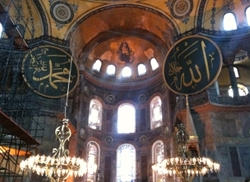 |
 |
![]()
|
Archives |
|
|
A Witness to Triumphs and Terrors
Over the course of the coming year, much of my focus at the Global Organization of Parliamentarians Against Corruption (GOPAC) will be on work with international institutions to locate, freeze, and ultimately restore to the Syrian people assets stolen from them by the Assad regime. Our objective is to starve the regime of the resources it has been using to perpetuate the conflict, and to thereby help bring the war to an earlier conclusion. The work will require me to travel quite extensively, and I plan to write a series of personal vignettes on the people, places, and customs I encounter, which will be published by the Huffington Post. I wrote my first article of the series during a brief moment of contemplation between intense discussions in Istanbul. * * * Recently, work took me to Istanbul to meet with the Syrian resistance. We discussed options for the international community to help bring an end to the Syrian war, by destroying the financial networks that enable the Assad regime to purchase weapons and finance assaults against civilians. As we pored over accounts of massacres, a clawing despair seemed to grip us, and it became difficult to hold on to any sense of perspective. One afternoon, I decided to clear my mind and pay a brief visit to the Hagia Sophia, the monumental edifice in the ancient heart of the city. The “Holy Wisdom” is almost 1500 years old, and is - at least in my amateur opinion - the single greatest masterpiece of Byzantine architecture. Its history is intertwined with the history of civilisation itself, and it has outlasted both the highest triumphs and the lowest terrors nations have known. It became the centre of the state religion, Orthodox Catholicism, as the Western Roman Empire declined and the Eastern Roman Empire arose. It was converted into an imperial mosque a thousand years later, when the Eastern Roman Empire was conquered by the Ottoman Empire. It was secularised into a museum almost five hundred years later, after the First World War delivered the deathblow to the decaying Ottoman Empire. It is difficult to conceive of how much change this building has survived, or how important it remained even as the world order ebbed and flowed around it. Today, it bears the accumulated fingerprints of its Christian, Muslim, and secular eras. Images of Jesus and the Virgin Mary gaze down upon enormous discs bearing the names of Allah and the Prophet Mohammad, all hovering over a vast chamber where the modern Turkish state has banned any religious activity. It also has an unmistakable air of faded grandeur. The ancient mosaics are crumbling, and the rim of its colossal dome now traces a worryingly oblong path atop its walls. Its history is intertwined with the history of civilisation itself, and it has outlasted both the highest triumphs and the lowest terrors nations have known. For one-and-a-half millennia, millions of people of different faiths passed through the Hagia Sophia, giving thanks for their joys or seeking solace for their miseries, hoping or fearing that the world would never change. Yet, all the while, the Hagia Sophia has remained a silent witness to the fact that world has done nothing but change. It is a comfort for everyone struggling to change any part of the world for the better. |
|
|
|
|
|
|
|
Remembering Desmond Tutu |
|
|
My article in the Globe and Mail |
|
United Nations |
|
|
My address in the UN General Assembly Chamber |
|
CHCH TV |
|
|
My interview on the Gaza peace plan |
|
CPAC |
|
|
My press conference with the Canadian Interfaith Conversation |
|
|
|


